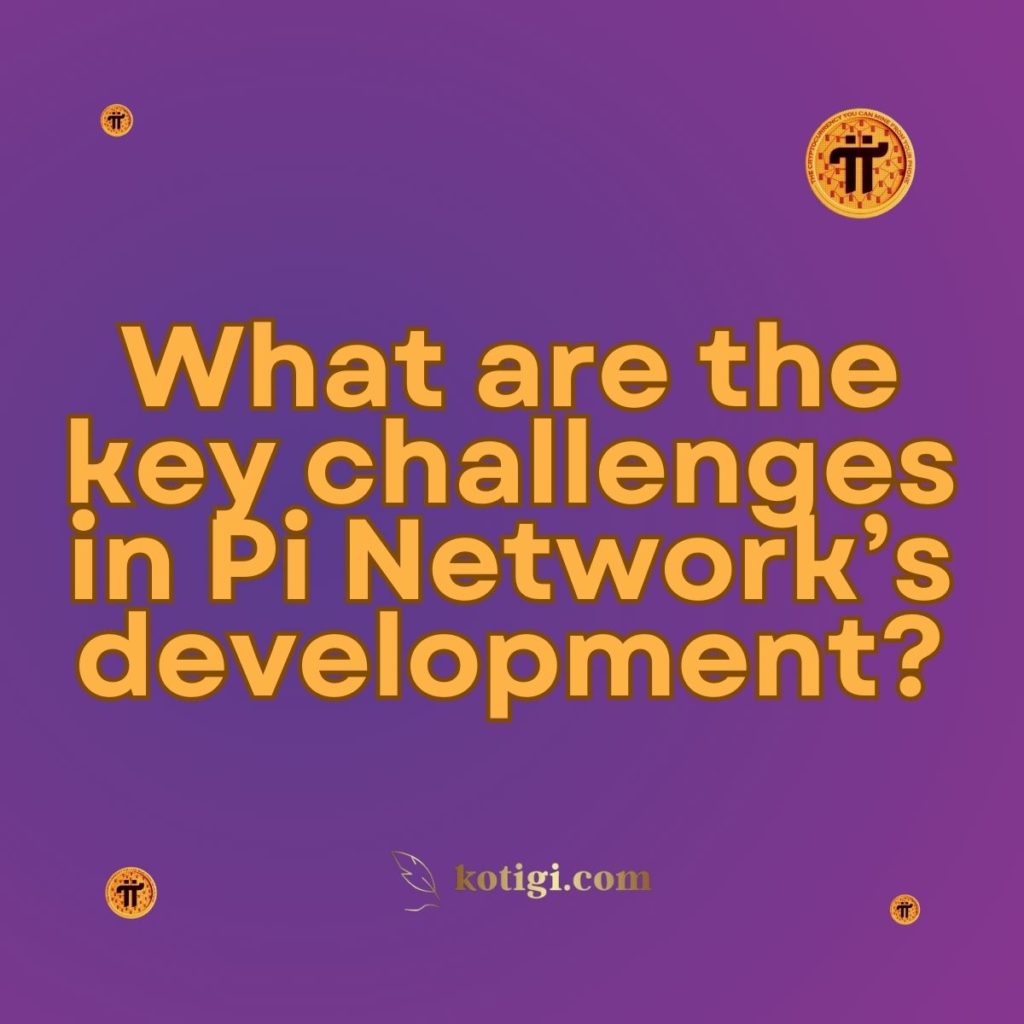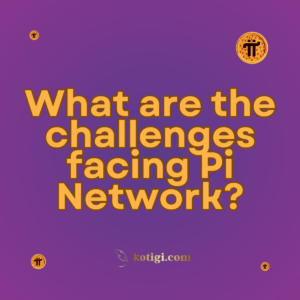
What are the key challenges in Pi Network’s development?
Pi Network faces several key challenges in its development, including scaling its infrastructure to handle millions of users, maintaining decentralized governance, ensuring regulatory compliance, and safeguarding user security. As Pi Network continues to grow, overcoming these obstacles is crucial for its long-term sustainability and mass adoption. Each of these challenges represents a significant hurdle, but they are also opportunities for the project to strengthen its platform and achieve its vision of becoming a globally accepted cryptocurrency.
Introduction
Pi Network has emerged as one of the most promising decentralized cryptocurrency projects, attracting millions of users across the globe. However, with this rapid growth come several challenges that the Pi team must address to ensure the project’s long-term success. From scaling its infrastructure to regulatory compliance and user security, Pi Network faces a range of obstacles that must be tackled carefully to maintain momentum.
In this article, we will explore the key challenges in Pi Network’s development and examine how the project is working to overcome these hurdles. Understanding these challenges is essential for both current and prospective Pi users who want to engage with the platform.
Scaling Infrastructure
Handling Millions of Users
One of the most significant challenges Pi Network faces is scaling its infrastructure to support its rapidly growing user base. With over 35 million users, the network requires robust technology capable of processing transactions efficiently without compromising speed or security. As more users join, the strain on the platform’s servers increases, potentially causing delays in transaction verification and network performance.
To address this, Pi Network is continually upgrading its infrastructure to ensure that it can handle the influx of new participants. The development team focuses on enhancing server capacity and optimizing the blockchain to accommodate millions of users without sacrificing decentralization.
Ensuring Transaction Efficiency
Another aspect of scaling is maintaining transaction efficiency as the network expands. Cryptocurrencies like Bitcoin and Ethereum have faced scalability issues, leading to high transaction fees and slow processing times. Pi Network aims to avoid these pitfalls by designing a scalable blockchain architecture from the outset. However, this remains a challenge as the project evolves, requiring continuous innovation and testing to ensure smooth operations.
Decentralized Governance
Maintaining Decentralization
Decentralized governance is a core principle of Pi Network, but it presents its own challenges. As the project grows, ensuring that decision-making remains decentralized and not dominated by a small group of individuals is critical. Pi Network is working to create a governance model where users can participate in key decisions, ensuring that the network stays true to its decentralized ethos.
However, decentralized governance can slow down decision-making processes, as consensus must be reached among a large number of stakeholders. Balancing efficiency with inclusivity is a key challenge for Pi Network as it transitions into its open mainnet phase.
Implementing Voting Mechanisms
To maintain decentralized governance, Pi Network plans to implement voting mechanisms that allow users to have a say in the future direction of the project. While this is an essential part of ensuring a democratic system, implementing these mechanisms in a fair and secure manner presents a challenge. Pi Network must develop a system that prevents vote manipulation, encourages participation, and ensures transparency.
Regulatory Compliance
Navigating Global Regulations
As Pi Network grows, it must navigate an increasingly complex regulatory environment. Cryptocurrency regulations vary widely across different countries, with some nations adopting crypto-friendly policies while others impose strict restrictions. Pi Network must ensure that its operations comply with the diverse legal frameworks of various regions, which can be a daunting task.
Ensuring compliance with anti-money laundering (AML) and know-your-customer (KYC) regulations is particularly important for Pi Network as it prepares for its open mainnet. Failure to comply with these regulations could lead to legal issues, fines, or even restrictions on the project’s operations in certain jurisdictions.
Ensuring User Privacy and Security
Regulatory compliance must be balanced with user privacy, which is a cornerstone of cryptocurrency platforms. Pi Network must implement robust KYC protocols to comply with regulations, while also ensuring that users’ personal information is safeguarded. Maintaining this balance between regulatory compliance and user privacy is a challenge that requires careful planning and execution.
Security Challenges
Protecting the Network from Attacks
As Pi Network continues to grow, it becomes a more attractive target for malicious actors. Cyberattacks, including hacking attempts, phishing scams, and denial-of-service (DDoS) attacks, pose a significant threat to the platform. Ensuring the security of the network and protecting user data is one of Pi Network’s top priorities.
The Pi development team must continually update its security protocols and implement best practices to prevent these types of attacks. This includes educating users on how to recognize and avoid scams, as well as strengthening the network’s defenses against potential vulnerabilities.
User Education on Security Practices
A key component of Pi Network’s security strategy is educating its users on best security practices. Many users may be new to cryptocurrencies and unaware of the risks associated with digital assets. Ensuring that users are knowledgeable about securing their accounts, recognizing phishing attempts, and using two-factor authentication is essential to maintaining a secure network.
Network Sustainability
Ensuring Long-Term Viability
Pi Network’s long-term sustainability is another key challenge. Building a decentralized network that can function efficiently and securely over time requires careful planning and continuous innovation. As the project moves closer to its open mainnet, it must ensure that the platform can sustain itself through transaction fees, incentives for validators, and other economic mechanisms that support network operations.
The sustainability of Pi Network also depends on its ability to maintain a strong and engaged community. Encouraging ongoing participation and ensuring that the network provides real value to its users are critical for Pi’s long-term success.
Developing an Economic Model
Pi Network must develop a sustainable economic model that incentivizes users to participate in securing and maintaining the network. This includes creating a fair reward system for validators and ensuring that transaction fees remain low enough to encourage widespread use of the platform. Balancing these factors is a challenge, as the economic model must ensure that Pi Network remains attractive to users while also being financially viable.
User Adoption and Growth
Driving Mass Adoption
While Pi Network has gained significant traction, driving mass adoption remains a challenge. For the network to succeed, it must expand beyond its existing user base and attract individuals and businesses who will use Pi for everyday transactions. Educating the public about the benefits of Pi and encouraging its use in real-world applications is essential for mass adoption.
Pi Network must also address the “network effect” challenge, where the value of the platform increases as more people use it. To achieve this, the project needs to create more use cases for Pi and integrate it into various industries, such as retail, e-commerce, and digital services.
Competing with Other Cryptocurrencies
Pi Network operates in a highly competitive environment, where established cryptocurrencies like Bitcoin, Ethereum, and newer projects all vie for market share. For Pi Network to stand out, it must differentiate itself by offering unique features, such as its user-friendly mobile mining app and its focus on decentralization and accessibility.
Competing with other cryptocurrencies requires Pi Network to continually innovate and ensure that its technology, community, and ecosystem are robust and appealing to a broad range of users.
Conclusion
The key challenges in Pi Network’s development—scaling infrastructure, maintaining decentralized governance, ensuring regulatory compliance, securing the network, and driving mass adoption—are significant, but they also present opportunities for the platform to strengthen its foundations. By addressing these challenges head-on, Pi Network can build a sustainable, secure, and globally adopted cryptocurrency. As the project moves closer to its open mainnet, overcoming these hurdles will be crucial for its long-term success.
Key Takeaways
- Scaling Infrastructure: Pi Network faces challenges in managing its growing user base while maintaining transaction efficiency and network performance.
- Decentralized Governance: Ensuring decentralized decision-making through secure voting mechanisms is critical for the platform’s future.
- Regulatory Compliance: Navigating global cryptocurrency regulations and balancing compliance with user privacy is a major hurdle.
- Security Risks: Protecting the network from cyberattacks and educating users on security practices is essential for maintaining a secure ecosystem.
- Sustainability and Growth: Developing a sustainable economic model and driving mass adoption are crucial for Pi Network’s long-term viability.



